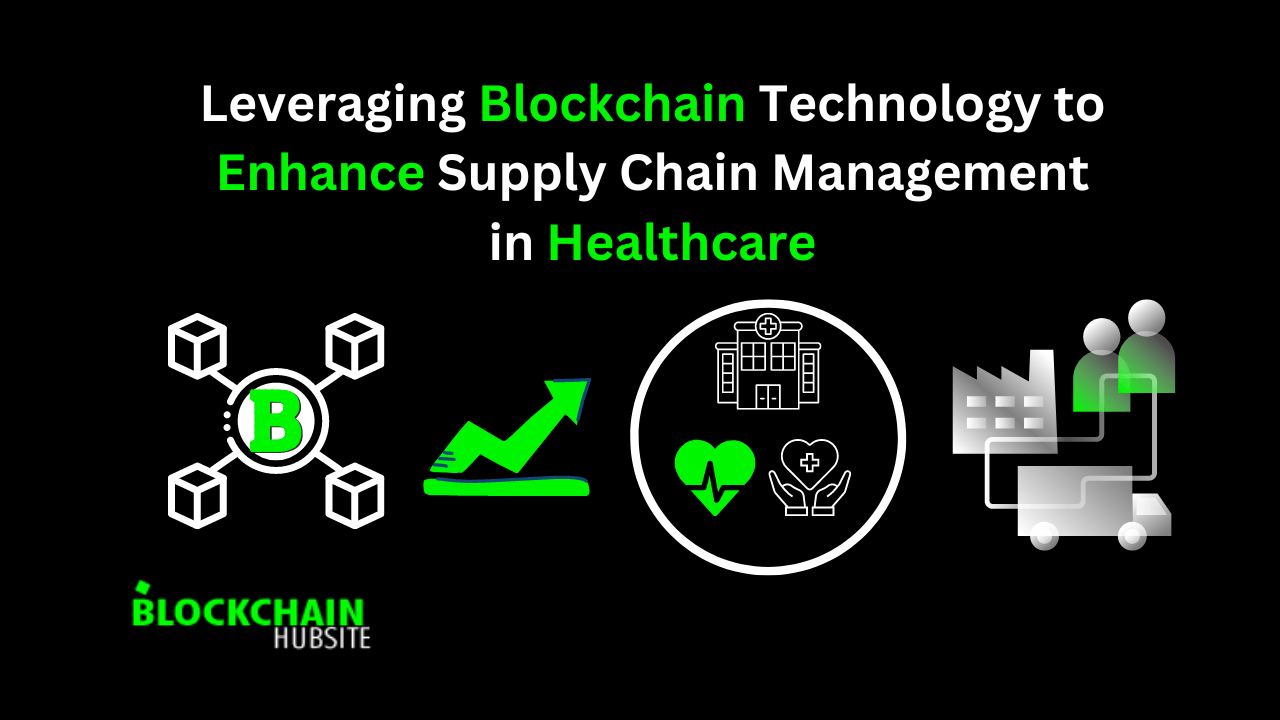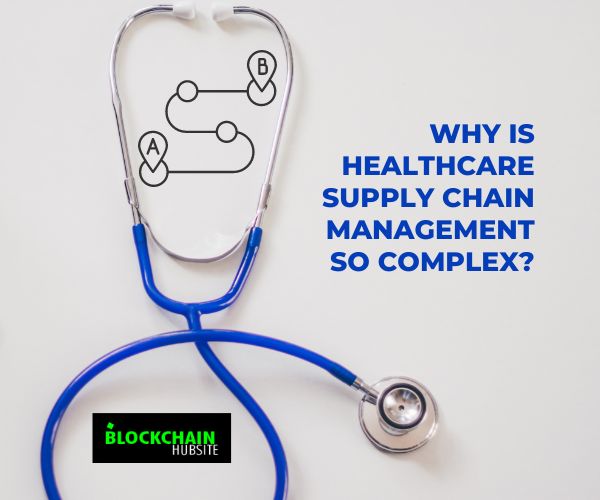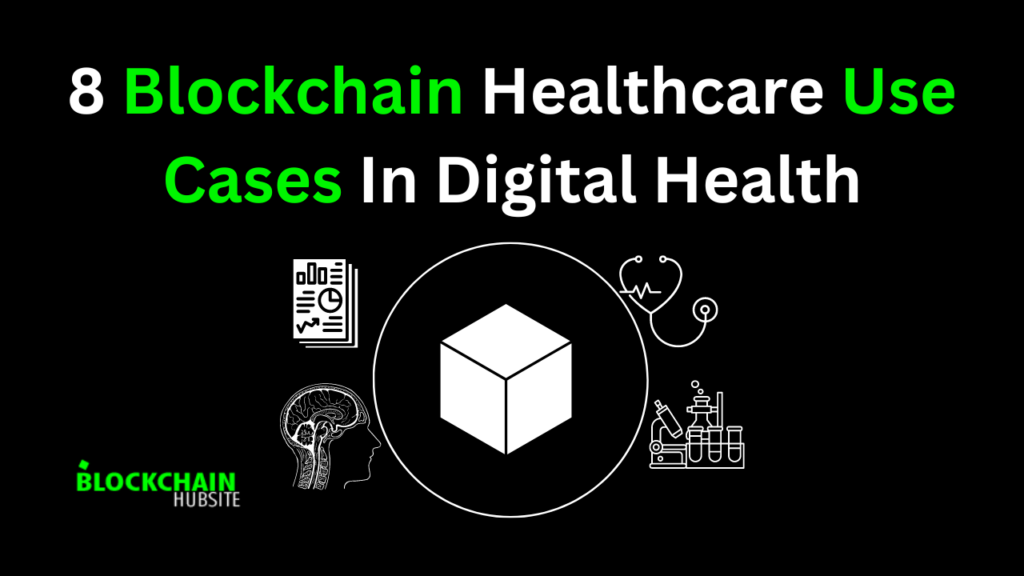
The healthcare industry faces several difficulties due to rising worldwide expenses and the dispersed character of the healthcare supply chain. Therefore, healthcare needs cost-effective, efficient ways to improve supply chain operations and processes. To reduce costs and gain greater control over their supply chains, some of the biggest names in healthcare are looking into blockchain technology.
Blockchain technology has enormous potential to improve healthcare supply chain management. Tracking and regulating the movement of pharmaceuticals, medical equipment, and other healthcare products from producers to end users, including hospitals, clinics, and pharmacies, is the challenging job of healthcare supply chain management.
There have been several issues with healthcare supply chain management, including a need for more visibility, accountability, and traceability. Unfortunately, these problems can lead to the introduction of counterfeit or substandard items onto the market, which raises risks to patient safety and can result in financial losses. Blockchain technology, however, can help solve these problems and improve the healthcare supply chain, making it more reliable and efficient.
When tracing products along the supply chain in health care, challenges with transparency, IT, and tracking costs arise. Blockchain’s shared digital ledger can instantly track high-value products, solving these difficulties.
What is Healthcare Supply Chain Management?
It means keeping track of and managing the flow of medicines, medical goods, and healthcare services from the manufacturer to the patient. This helps ensure that doctors and patients get the medicines and treatments they need when and where they need them.
Supply chains are “interconnected processes by which a product or service is moved from its point of origin to its point of consumption.” Similar to how supply chain management works in a manufacturing setting, health supply chains can be described by their different ways of integration:
This includes process integration, information flow coordination, and strategic planning process coordination.
• Integration of internal and external business procedures.
• Integration of market-oriented methods.
• Including market growth.
But supply chain management in healthcare is complex. Because medical supplies, drugs, and other essential resources are ordered in different places, the supply chain process could be harmed, directly affecting patient safety.
WHO research shows that more than 100,000 people die yearly in Africa because they were given the wrong dose of fake drugs they got from people they didn’t know or trust.
Several factors, including product and drug counterfeiting, a lack of a product registry, and packaging problems, could disrupt the SCM at a healthcare facility.
Why is Healthcare Supply Chain Management so Complex?

Each healthcare supply chain partner has various needs to safeguard.
In addition, different parts of the flow of the supply chain may have their own goals. For example, providers may want to use a particular product because they were trained on it, but hospital officials want to buy the best items at the best price. Meanwhile, medical device companies might want to make money from their goods.
Since supply chain objectives are only sometimes compatible within an organization, healthcare supply chain management can be inefficient and disorganized.
In addition, when deciding on product costs, healthcare organizations have to consider many different requests and points of view. For example, providers may put their preferences for certain goods first, while financial managers try to cut costs and get rid of products that are no longer useful. Often, hospitals have to deal with providers who store or hide away certain goods.
“Most of the time, clinicians only want the products when needed,” explained Spann. “But to ensure that happens, they often hoard or choose to manage their supplies. This may be a factor in off-contract spending and cost fluctuation, which are difficult to detect. Another hidden cost is the time spent searching for supplies or waiting for delivery.
This is true in healthcare supply chain management in general, but the COVID-19 epidemic has also left its mark. Nearly a year after the pandemic’s start, a 2021 analysis of one of the largest GPOs in the country showed that healthcare organizations were still struggling to meet the increased demand for personal protective equipment (PPE) and other supplies.
The healthcare supply chain still struggles with COVID-19, RSV, and the flu. As a result, healthcare organizations need help getting enough supplies, and they also have to pay more for everyday things and have less equipment.
Organizations that want to cut costs and improve care must ensure their supply chain works well. For example, on average, hospitals today spend around 20% of their budget on medical supplies. In addition, costs in the supply chain are expected to go up because of inflation and the higher prices of medical items and devices.
Issues in the Health Supply Chain Management System

Challenges in health supply chain management include:
- A practical vehicle identification method is needed in smart transportation to prevent unauthorized users from tampering with data and information.
- Its responsibility is to make sure the communication reaches the intended receiver.
- The other issue is that smart devices must always be available.
- IoT devices are now used in some supply chain systems to move medical equipment. The biggest problem with IoT is that devices have limited storage and processing power, making them easy targets for security attacks. It’sIt’s imperative to have strong security and privacy measures.
- For a supply chain to be smart, goods must be sent to the right person at the right time and place. This can only be done with a secure infrastructure.
- Due to centralized control, a lack of accurate information, and competition between parties, it’s hard to keep track of medical components as they move through the supply chain network.
- Tracing, transparency, and quality of information become significant challenges within healthcare supply chains because of their complex structure, which connects multiple firms across multiple geographical boundaries.
- So many lives have been sacrificed, and the healthcare industry has suffered significant financial losses due to the prevalence of counterfeit medications in the global market today.
What is Blockchain Technology?
The blockchain is a distributed ledger where records of transactions can be stored.
In particular, blockchain is a shared, immutable record of peer-to-peer transactions. A distribution ledger is “a type of database that is shared, replicated, and synchronized among the members of a network.” The distributed ledger records and verifies transactions between nodes in a network.
Blockchain for Healthcare Supply chain management
In healthcare supply chain management, blockchain transactions are a vital way to track how drugs and medical goods move through the supply chain. Since all transactions are recorded on the ledger, and every node in the blockchain keeps a record, it is easy to quickly check where the drug came from and who sold it. Also, the distributed record of the blockchain lets healthcare officials and doctors check suppliers’ credentials and ensure they are real.
A more thorough and rapid authentication process will give pharmacies and healthcare professionals more visibility into the supply chain, allowing them to continue delivering authentic medications to needy patients. Blockchain technology can create a trustworthy vendor network to protect patients from dishonest suppliers. Additionally, blockchain technology promises significant improvements in demand forecasting, data provenance, fraud prevention, and transaction.
• Step 1: A block is made when a new medicine or medical treatment is invented. This includes patent security and a long process of clinical trials. This data is recorded as a transaction on the distributed ledger.
• Step 2: After the successful clinical trial, the patent is sent to the manufacturing company for a test prototype and mass production. Every product has a unique identifier linked to another transaction or block in the blockchain. This block can contain other information that is important to the product.
• Step 3: Once mass production and packing are done, the medicine is stored in a warehouse until it is ready to be sent out. In the blockchain, you can find the time, date, lot number, barcode, and expiration date.
• Step 4: The blockchain stores details on transportation, such as the time it takes to move goods from one warehouse (IN) to another, how they are moved, the authorized agent, and so on.
• Step 5: A third-party distribution network sends Drugs and medical equipment to doctors’ offices and pharmacies. For this purpose, a central warehouse (called an “OUT””) is used, to which all distribution nodes are connected. Another transaction is added to the ledger as well.
• Step 6: Care providers, like hospitals or clinics, must give information, like the batch number, lot number, product owner, and expiration date, to verify and stop fakes. The blockchain also contains this information.
• Step 7: The steps conducted by a store are pretty similar to those taken in Step 6.
• Step 8: Patients are urged to verify product authenticity at every stage of the process, thanks to the transparency of the data provided by the blockchain supply chain.
Potential Applications of Blockchain in Healthcare Supply Chain

- Tracking pharmaceutical products: Blockchain can track the movement of pharmaceutical products from the manufacturer to the end user. By recording each transaction and change of ownership on a blockchain, parties can see what’s happening in the supply chain at any time. In addition to lowering the chance of medication mistakes, this transparency helps maintain the integrity of the supply chain and prevent the sale of fake medications.
- Ensure the authenticity of medical devices and equipment: Blockchain can be used to verify the validity of medical devices and equipment. Stakeholders can quickly determine where an item came from and who owned it by looking up its blockchain-recorded manufacture, certification, and maintenance data. This helps find and stop the spread of fake or low-quality tools, ensuring patients are safe.
- Streamlining the distribution of vaccines and medicines: Blockchain can make the distribution more efficient and transparent. Stakeholders can monitor the flow of vaccinations and pharmaceuticals from the manufacturer to healthcare facilities more precisely because of the blockchain’sblockchain’s distributed ledger and immutability. This reduces supply chain inefficiencies, drug stock-outs, and late end-user delivery.
- Enhancing data security and privacy: Blockchain can improve data security and privacy in healthcare supply chains. A blockchain can securely store and distribute medical records, patient data, and supply chain data. Blockchain-based solutions can also give people more control over their health data by letting them give access to specific healthcare providers while keeping their privacy.
- Facilitating regulatory compliance: Blockchain technology can help ensure regulatory compliance in the healthcare supply chain. By putting regulatory requirements, certifications, and audits on a blockchain, stakeholders can quickly check compliance and show that they follow industry standards and laws. This can improve supply chain trust, streamline audits, and reduce paperwork.
Benefits of Leveraging Blockchain Technology in Healthcare Supply Chain Management
- A blockchain supply chain ledger is beneficial for supply chain managers handling high-value items.
- Hospitals must track high-value items like organs, blood products, medications, and medical implants.
- Strict transportation rules for organs and medicines can be tracked using a distributed blockchain log.
- Blockchain enables efficient tracking and management of high-value items at every stage of the supply chain.
- Real-time tracking improves inventory management, reduces courier costs, identifies supply chain issues faster, minimizes mistakes, and optimizes resource utilization.
- Incorporating blockchain in organ transportation supply chain management can enhance patient organ allocation rates and provide an immutable record.
- Blockchain facilitates managing time-sensitive issues such as organ removal, transportation duration, and arrival time at the recipient facility.
- Electronic tracking using blockchain helps identify problems or inefficiencies in the organ delivery system.
- Blockchain technology allows for increased efficiency, regulatory compliance, and the exploration of new organ transport methods like drones.
- DonorNet is an example of using blockchain in healthcare, revolutionizing organ transplantation through secure communication and data preservation.
- DonorNet enables effective organ allocation and placement, matching donors and recipients according to UNOS guidelines.
- Blockchain eliminates intermediaries and allows direct communication between organ procurement organizations (OPOs) and transplant centers.
- Blockchain ensures well-informed judgments about organ acceptance by providing standardized and UNOS-specified donor information.
- Blockchain provides a dynamic system for alerting potential transplant facilities of donor information changes and addressing patient safety concerns.
- Blockchain improves tracking of organ transit, particularly for kidney allografts retrieved from distant locations.
- Blockchain enables precise tracking of organ transportation, ensuring accountability and transparency.
- Blockchain technology enhances the security of implanted and wearable medical devices by tracking them in the supply chain.
- Blockchain safeguards devices like pacemakers and infusion pumps, protecting against hacking and ensuring patient safety.
- Blockchain enables secure storage and real-time health data monitoring from wearable medical devices.
- Through blockchain-based tracking, patients and healthcare professionals can effectively manage data from wearable devices.
- Blockchain can be used for maintenance and performance logs of high-tech medical equipment in hospitals.
- Maintenance, updates, and repairs of expensive medical machines can be accurately recorded using blockchain.
Implementation Challenges and Consideration

The potential benefits of blockchain in healthcare supply chain management are significant, but there are various implementation challenges and considerations. This includes:
Regulatory Compliance: Because healthcare is a strongly regulated industry, deploying blockchain technology requires compliance with existing regulations governing data privacy, security, and patient confidentiality. Blockchain solutions must comply with HIPAA and GDPR to legally and ethically use patient data.
Technical Difficulties: Several technical challenges must be overcome to implement blockchain technology. These include selecting the best blockchain platform, creating the architecture, and integrating existing systems into blockchain networks. Healthcare businesses must invest in trained employees and technological skills to manage these obstacles and ensure successful adoption.
Scalability and Performance: These two aspects are crucial since healthcare supply chains involve significant transactions and data. Blockchain networks must handle rising demand while still processing transactions effectively. Scalability solutions such as sharding or layer-two protocols may be required to overcome these issues.
Interoperability and standardization: For smooth data interchange and collaboration, multiple healthcare systems, organizations, and blockchain networks must achieve interoperability. Standardized standards and protocols for data formats, smart contracts, and communication interfaces must be established to ensure compatibility and interoperability.
Collaboration and Governance: Successful blockchain adoption in healthcare supply chain management necessitates collaboration among numerous stakeholders, such as healthcare providers, manufacturers, regulators, and technology suppliers. Cooperation, decision-making, and shared standards can be facilitated by establishing governance structures, consortiums, or industrial alliances.
Cost and Return on Investment: Implementing blockchain technology experiences expenditures for infrastructure, development, training, and continuous maintenance. To justify the deployment, healthcare institutions must carefully weigh the expenses vs. the potential return on investment. Therefore, thorough cost-benefit analysis and the development of solid business cases are critical phases in the decision-making process.
Successful Case Studies of Blockchain Adoption in Healthcare Supply Chains
1. IBM’s partnership with the FDA to verify the drug supply line
In 2019, IBM worked with the U.S. Food and Medicine Administration (FDA) to look into how blockchain technology could make the medicine supply chain more secure and transparent. The project aimed to make tracking and checking prescription drugs easier as they moved from the manufacturer to the pharmacy along the supply chain. Using blockchain technology, stakeholders can access an immutable transaction record, confirming the medications’ legitimacy and integrity.
2. MediLedger Project
Making the pharmaceutical supply chain more efficient: The MediLedger Project, led by a consortium of pharmaceutical corporations, intends to improve the pharmaceutical supply chain’s efficiency and security. The project uses blockchain technology to speed up several processes, such as drug recalls, chargebacks, and verifying that trade partners can do business together. As a result, the blockchain-based system has reduced costs, inefficiencies, and supply chain trust.
3. Initiatives to trace the supply chain in underdeveloped countries
In developing countries, blockchain-based tracking projects have been set up to deal with problems like fake drugs, inefficient supply chains, and insufficient data management. For example, in Ghana, the government worked with tech companies to create a blockchain-based system that makes it easier to check the quality of drugs and gives more information about the supply chain. Similar projects have been started in India and other places.
Key Stakeholders and Their Roles in Implementing Blockchain

Manufacturers, distributors, and wholesalers
These stakeholders are in charge of manufacturing, distributing, and wholesale pharmaceutical items and medical supplies. Manufacturers can use blockchain technology to keep track of important information about their goods, like batch numbers, expiration dates, and certifications.
Using blockchain, wholesalers, and distributors may streamline inventory management, verify the legitimacy of products, and trace their items as they move between locations. In addition to contributing to the supply chain, they can help the blockchain network by verifying transactions and disclosing helpful information.
Healthcare providers and hospitals
Hospitals, clinics, and pharmacists are all healthcare providers important to the healthcare supply chain. They depend on a steady supply of medicines, medical devices, and tools.
Using blockchain technology, healthcare providers can check the availability, authenticity, and quality of goods in real time. This lets them make smart choices, get the most out of their inventory management, and keep patients safe. Healthcare professionals can also aid in the blockchain’s transparency and traceability by documenting information about product use, patient outcomes, and adverse occurrences.
Regulatory bodies and government agencies
Regulatory bodies and government agencies are significant in healthcare because they ensure compliance, safety, and quality standards are met. In addition, they set rules and instructions for how pharmaceuticals and medical devices are made, distributed, and used.
In implementing blockchain, regulatory bodies can work with stakeholders to set guidelines and requirements for how data is recorded, kept secure, and kept private on the blockchain. They can also use blockchain technology to improve regulatory oversight, track how goods move, and ensure safety rules are followed. By joining the blockchain network, government bodies can help ensure the healthcare supply chain stays transparent and truthful.
Integration of IoT and Blockchain for Real-time Monitoring

Integrating blockchain and the Internet of Things (IoT) in the healthcare supply chain has much potential to make the business more transparent, safe, and efficient. When these two technologies are used together, they can help healthcare groups deal with problems like fake drugs, data integrity, and supply chain management. IoT and blockchain can work together in the healthcare supply chain in the following ways:
1. Product Authentication
Blockchain can be used to check the authenticity of pharmaceutical goods. Each thing can be given a unique digital name recorded on the blockchain. IoT devices, like sensors or RFID tags, can track and monitor how these goods move through the supply chain. These gadgets can collect information about location, temperature, and other essential factors. This information is then safely stored on the blockchain. Integrating the Internet of Things data with the immutability of the blockchain helps stakeholders check that items are authentic and haven’t been tampered with.
2. Traceability in the supply chain
Healthcare goods can be tracked from beginning to end with the help of IoT sensors and blockchain. The blockchain can record every transaction, including the transfer of products and data, providing an immutable audit trail. In addition, IoT devices can constantly collect and send real-time information about the condition and location of goods. This makes sure that the entire supply chain is transparent and accountable. This level of traceability helps detect delays, optimize processes, and lessen the danger of counterfeit or expired products entering the market.
3. Smart Contracts
Smart contracts are a feature of blockchain that can be used to automate and maintain agreements between parties in the healthcare supply chain. When certain conditions are met, like the successful completion of delivery or the verification of product quality, smart contracts can trigger rapid payment.
IoT devices can send the data needed to check that these conditions are met and start smart contracts running. This automation helps save time and money by decreasing the need for human intervention in payment and reconciliation procedures.
4. Data Security and Privacy
Combining blockchain and IoT can make healthcare data safer and more private. IoT devices can send data to the blockchain safely, protecting the data’s integrity and preventing unauthorized access or changes. The fact that blockchain is autonomous makes it hard for bad people to change data, which adds another layer of security. Also, patients can have more control over their data by letting certain people and organizations access and use it.
5. Improved Data Analytics
When IoT data is combined with blockchain data, healthcare companies can gain valuable insights for data analytics and research. The quality and dependability of analytics can be improved because data on the blockchain is transparent and correct. Researchers can access historical and real-time data for reliable analysis and healthcare innovation.
Conclusion
In conclusion, blockchain technology can improve the healthcare supply chain’s efficiency, accountability, and trustworthiness. It can help with problems like fake drugs, inefficient store management, and concerns about data privacy. Blockchain increases security, automates compliance, and secures data sharing. Collaboration and interoperability between companies can help solve problems faster and improve patient care. Blockchain could improve healthcare supply chains and aid patients, despite its issues.
FAQs
1. How can blockchain improve supply chain management?
Blockchain technology has the potential to give real-time visibility and tracking of materials and goods across the whole supply chain, from production to distribution to end users. This contributes to greater transparency and trust among supply chain participants.
2. How can blockchain improve healthcare?
Blockchain’s distributed ledger technology allows for the safe transfer of patient medical information, improves healthcare data security, manages the medicine supply chain, and helps healthcare researchers unlock genetic code.
3. Why is blockchain important in healthcare?
Blockchain has numerous uses and functions. For example, when certain conditions are met, like the successful completion of delivery or the verification of product quality, smart contracts can trigger rapid payment.
4. What is the future of blockchain in healthcare?
Blockchain is a distributed database that enables the safe, transparent, and tamper-proof management of healthcare data. When applied to healthcare, blockchain technology can assist in tackling some of the industry’s most common problems, such as data breaches, interoperability concerns, and fraud.
5. How does blockchain affect supply chain performance?
According to Brookbanks and Parry (2022), a blockchain-based platform develops shared trust, lowers data duplication, and increases supply chain visibility. A BCT’s crucial components are immutable records, smart contracts, and data management using distributed technologies.




